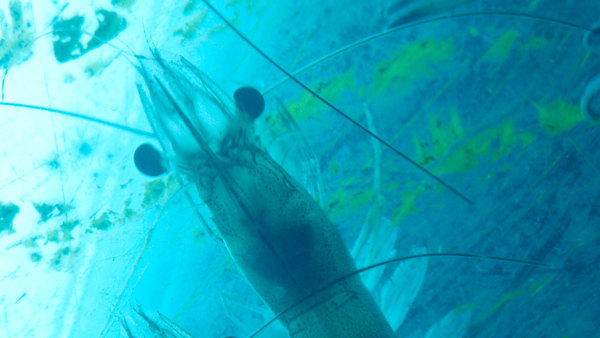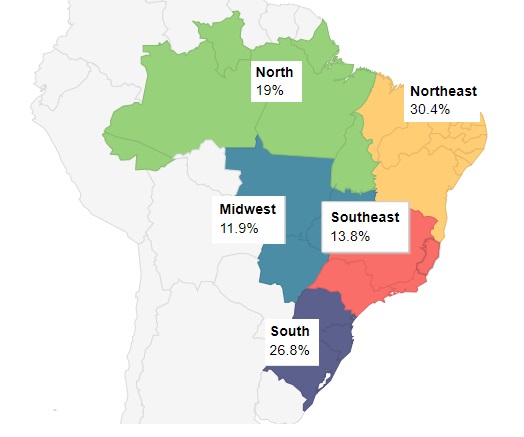
Content sponsored by:
Phileo by Lesaffre
The Brazilian Aquaculture Industry
Published: July 26, 2018
Source : Phileo Lesaffre Animal Care. Alberto Nunes

In 2013, aquaculture production in Brazil reached 387,7 MT. Since 2003, production is growing at an average rate of 9.3% (FAO, 2014). Aquaculture production is spread to all geographical regions in Brazil, but the Northeastern accounts for more than ¼ of the total (Fig. 1). There are three major aquatic animal groups farmed in the country: freshwater fish, marine shrimp and mollusks. Freshwater fish are split into indigenous species, tilapia and carp. Tambaqui, Colossoma macropomum, and the tiger Brazilian catfish, Pseudoplatystoma fasciatum, are the main representatives of other family-related indigenous fish. Hybrid fish is also commonly farmed in commercial operations. Production of tambaqui is prevalent in the Northern and Midwestern regions in Brazil, while its hybrids are found in parts of the Northeastern and Southeastern regions. Farming of the Brazilian tiger catfish and its hybrids is more widespread in states of the Midwestern region. These species are reared in fed-based semi-intensive systems. Crops can last between 6-12 months, depending on desirable fish weight, which is market-dependent, but usually range from 0.8 to 2.5 kg.
Carp corresponds to 4.9% of the total domestic aquaculture production. Farming of carp dates back to German and Italian immigration in the past century. Although carp introduction occurred to other parts of the country, today farming is mainly restricted to the Southern Brazil where polyculture and extensive farming methods prevail. Almost half (43.7%) of all aquaculture production in Brazil is done with the Nile tilapia, Oreochromis niloticus. The species is practically distributed in all regions, but farming is more significant in the Northeastern and Southeastern parts of the country. Intensive cage farming systems are popular for tilapia in Brazil. Abundant freshwater resources in man-made reservoirs for power generation or to attenuate droughts in semi-arid regions of the country have allowed rapid expansion of tilapia farming under this system. It can take 6 months from fingerling to a market size of 0.8-1.2 kg. Culture is heavily dependent on industrially compounded feeds.
Marine shrimp is produced primarily in the Northeastern region with the whiteleg shrimp, Litopenaeus vannamei. Farms can be located in coastal or inland areas. The species is predominantly cultured under semi-intensive earthen ponds. Crop periods are variable as it depends on targeted harvest size and market. Grow-out usually takes 70 to 90 days for shrimp of 8 - 12 g body weight, but weights above 22 g can exceed 6 months of grow-out. In 2013, production of the whiteleg shrimp accounted for 21.9% of the total harvested volume. The Pacific oyster, Crassostrea gigas, and the native mussel Perna perna dominate mollusk farming in Brazil. About 90% of the country´s production of 1,005 MT (FAO, 2014) is located in the Southern state of Santa Catarina.
In addition to economic drivers, there are also local market preferences in the country that lead farmers to choose producing one species against the other. Some species are perceived to be less risky business wise, e.g., tilapia versus marine shrimp, while others require fewer investments in capital inputs, such as feed and land. Freshwater can be scarce is some farming areas, and ability to grow under limited water exchange systems is also determinant, e.g., tambaqui and its hybrids. In general, farmers in Brazil choose species based on economic criteria, which include market prices, production costs, return on investment and profitability. Market and technical issues, including seed availability, resistance to diseases and rapid growth rates are vital.

Figure 1. Aquaculture production distribution by region. Source: Brazilian Ministry of Fisheries and Aquaculture. MPA (2013).
Source
Phileo Lesaffre Animal Care. Alberto NunesRelated topics:
Recommend
Comment
Share

Would you like to discuss another topic? Create a new post to engage with experts in the community.


